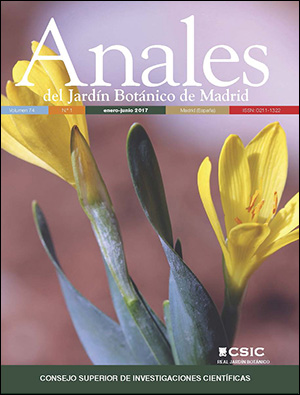Structure, biogenesis and nutricional dependence of Paxillus ammoniavirescens sclerotia (Boletales, Paxillaceae)
DOI:
https://doi.org/10.3989/ajbm.2454Keywords:
Mycorrhizal inoculum, histochemistry, nitrogen fertilization, reserve substances, temperatureAbstract
The objective of this work was to study the structure, composition, and biogenesis of Paxillus ammoniavirescens sclerotia, as well as their possible use as inoculum for birch mycorrhizae. By means of histochemical stains, a change of the composition and internal organization of these structures during their maturation was observed. The formation of sclerotia begins with a clustering of hyphae that gives rise to a structure with pseudoparenchyma in the central part; these immature sclerotia develop to form, at maturity, a pseudoparenchymatic outer cortex of 6 or 7 layers of hyphae around an inner medulla. The hyphae of mature sclerotia have a large number of protein bodies in contrast to scarce lipid accumulations. The formation of sclerotia is influenced by the characteristics of the culture medium and the temperature. The greatest number of sclerotia was obtained by reducing the concentration of the diammonium phosphate to 0.94 mM in the MMN medium, and maintaining the cultures at 8 °C for 2 weeks. Finally it was shown that the sclerotia of this species can be used directly as inoculum, both to generate mycelium in the culture media and to initiate mycorrhizae in birch plants in vitro.
Downloads
References
Coley-Smith, J.R. & Cooke, R.C. 1971. Survival and germination of fungal sclerotia. Annual Review Phytopathology 9: 65-92. https://doi.org/10.1146/annurev.py.09.090171.000433
Deacon, J.W. 2006. Fungal Biology ed. 4. Blackwell Publishing, Malden.
Ekblad, A., Wallander, H., Carlsson, R. & Huss-Danell, K. 1995. Fungal biomass in roots and extramatrical mycelium in relation to macronutrients and plant biomass of ectomycorrhizal Pinus sylvestris and Alnus incana. New Phytologist 131: 443-451. https://doi.org/10.1111/j.1469-8137.1995.tb03081.x
Fernández, R., Bertrand, A., Casares, A., García, R., González A. & Tamés, R.S. 2008. Cadmium accumulation and its effect on the in vitro growth of woody fleabane and mycorrhized white birch. Environmental Pollution 152: 522-529. https://doi.org/10.1016/j.envpol.2007.07.011 PMid:17719154
Fernández-Miranda, E. 2014. Hongos ectomocirrícicos de plantas le-osas en terrenos degradados de Asturias por actividad minera e industrial. Tesis Doctoral. Universidad de Oviedo, Oviedo.
Grenville, D.J., Peterson, R.L., & Piché, Y. 1985. The development, structure, and histochemistry of sclerotia of ectomycorrhizal fungi. II. Paxillus involutus. Canadian Journal of Botany 63: 1412-1417. https://doi.org/10.1139/b85-195
Harvey, L.M. 1991. Cultural Techniques for Production of Ectomycorrhizal Fungi. Biotechnology Advances 9: 12-29. https://doi.org/10.1016/0734-9750(91)90402-H
Lev, R. & Spicer, S.S. 1964. Specific staining of sulphate groups with alcian blue at low pH. Journal of Histochemistry & Cytochemistry 12: 309-309. https://doi.org/10.1177/12.4.309 PMid:14187344
Moore, A.E.P & Peterson, R.L. 1992. Effect of temperature on sclerotium induction in Paxillus involutus. Canadian Journal of Microbiology 38: 1197-1201. https://doi.org/10.1139/m92-197
Pearse, A.G.E. 1968. Histochemistry. Theoretical and applied genetics 1: 1-759.
Peterson, R.L., Massicotte, H.B. & Melville, L.H. 2004. Mycorrhizas: Anatomy and Cell Biology. CABI Publishing Series, Nueva York.
Willetts, H.J. 1971. The survival of fungal sclerotia under adverse environmental conditions. Biological Reviews 46: 387-407. https://doi.org/10.1111/j.1469-185X.1971.tb01050.x
Published
How to Cite
Issue
Section
License
Copyright (c) 2017 Consejo Superior de Investigaciones Científicas (CSIC)

This work is licensed under a Creative Commons Attribution 4.0 International License.
© CSIC. Manuscripts published in both the print and online versions of this journal are the property of the Consejo Superior de Investigaciones Científicas, and quoting this source is a requirement for any partial or full reproduction.
All contents of this electronic edition, except where otherwise noted, are distributed under a Creative Commons Attribution 4.0 International (CC BY 4.0) licence. You may read the basic information and the legal text of the licence. The indication of the CC BY 4.0 licence must be expressly stated in this way when necessary.
Self-archiving in repositories, personal webpages or similar, of any version other than the final version of the work produced by the publisher, is not allowed.















